TD1 - Statique des fluides
Exercice 1
Au fond d'un tube en U, on verse du mercure. on verse de l'eau dans l'une des branches et de l'aniline dans l'autre, de telle sorte que les surfaces libres soient dans un même plan horizontal.
L'eau occupe alors une hauteur \(h_1\) et l'aniline une hauteur \(h_2\)
Question
Quelle est la masse volumique de l'aniline \(\rho_a\) ?
Données :
masse volumique du mercure \(\rho_{Hg} = 13.6\ kg\ dm^{-3}\)
\(h_1 = 20\ cm\)
\(h_2 = 22.2 \ cm\)
Indice
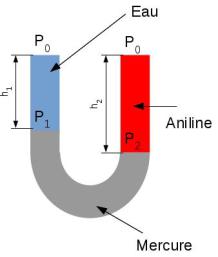
Indice
\(P+\rho g z = cte\)
Indice
eau : \( P_1 = P_0+\rho_e g h_1\)
aniline : \( P_2 = P_0+\rho_a g h_2\)
mercure : \(P_2-P_1 = \rho_{Hg}g (h_2-h_1)\)
Indice
\(P_2-P_1 = \rho_a g h_2 -\rho_e g h_1 = \rho_{Hg} g (h_2-h_1)\)
\(\rho_a = \frac{\rho_{Hg} g (h_2-h_1) + \rho_e g h_1}{gh_2}\)
Solution
A.N. \(\rho_a = 2249 \ kg \ m^{-3}\)
Exercice 2
Un bloc de bois de masse est lesté par un bloc de plomb.
Question
Calculer le poids du bloc de plomb pour que le solide flotte sur un liquide de densité \(d_l\) et que \(\frac{4}{5}\) de son volume soient immergés.
Données :
densité du bois \(d_b = 0.6\)
masse du bloc de bois \(m_b = 180 \ g\)
densité du plomb \(d_{pb} = 11.3\)
densité du liquide \(d_l = 0.9\)
Indice

Indice
Équilibre : \(\vec{P}+\vec{P_a}=0 \Leftrightarrow P=P_a\)
Indice
\(P_b+P_{Pb}=P_a=\frac{4}{5}\rho_lVg\)
\(m_bg+P_{Pb} = \frac{4}{5}\rho_ed_l(V_b+V_{Pb})g\)
avec \(V_b=\frac{m_b}{\rho_e d_b}\) et \(V_{Pb}=\frac{m_{Pb}}{\rho_e d_{Pb}}\)
\(m_b g+P_{Pb}=\frac{4}{5} g\frac{m_b}{d_b}d_l+\frac{4}{5}\frac{P_{Pb}}{d_{Pb}}d_l\)
Indice
\(P_{Pb}=\frac{gm_b\left(\frac{4d_l}{5d_b}-1 \right)}{1-\frac{4d_l}{5d_{Pb}}}\)
Solution
A.N. \(P_{Pb} = 0.377\ N\)
Exercice 3
Un cube d'aluminium de côté \(a\) est suspendu à une corde. Le cube est immergé à moitié dans l'huile et à moitié dans l'eau.
Question
Calculer la tension de la corde
Données :
\(a = 15\ cm\)
densité de l'huile \(d_h= 0.8\)
densité de l'aluminium \(d_{Al} = 2.64\)
Indice
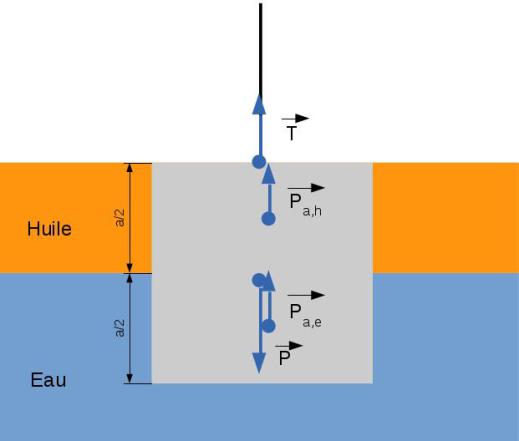
Indice
Équilibre : \(\vec{T} + \vec{P}+\overrightarrow{P_{a,e}}+\overrightarrow{P_{a,h}} = 0\)
Indice
\(\rho_{Al}Vg=T+\rho_e\frac{V}{2}g+\rho_h\frac{V}{2}g\)
\(T=Vg\left(-\frac{1}{2} (\rho_e+\rho_h)+\rho_{Al}\right)\) avec \(V=a^3\)
Solution
A.N. \(T=57.61\ N\)
Exercice 4
Un manomètre différentiel est formé de deux cylindres de sections droites respectives \(S_1\) et \(S_2\), reliés par un tube de section intérieure \(s\) constante.
L'ensemble contient deux liquides incompressibles non miscibles entre eux : l'eau de masse volumique \(\rho_e\) et l'aniline de masse volumique \(\rho_a\). Initialement la pression au dessus des deux liquides est la même (pression atmosphérique\( P_0\)). On provoque au dessus de l'eau du récipient de gauche une surpression \(\Delta P\).
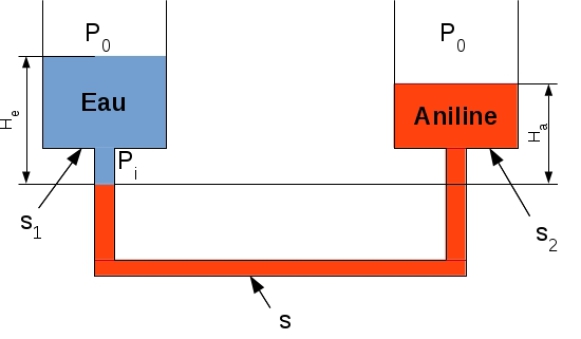
Question
Déterminer le déplacement \(\Delta h\) de la surface de séparation entre l'eau et l'aniline dans le tube.
On négligera tout phénomène lié à la tension superficielle au niveau des interface entre les différents fluides.
Évaluer la sensibilité \(\frac{\Delta h}{\Delta P}\) du manomètre. Commenter le résultats.
Données :
Masse volumique de l'aniline \(\rho_a = 1.024\ g\ cm^{-3}\)
Masse volumique de l'eau \(\rho_e = 0.998\ g\ cm^{-3}\)
\(S_1=S_2=100 \times s\)
Indice
A l'équilibre :
\(P_i\) = pression à l'interface eau-aniline
\(P_i = P_0+\rho_e g H_e = P_0+ \rho_agH_a\)
\(\rho_eHe=\rho_aHa\) (1)
Indice
Surpression \(\Delta P\) sur le réservoir de gauche rempli d'eau
\(\Rightarrow\) nouvelle interface \(\Rightarrow\) déplacement de \(\Delta h\)
Indice
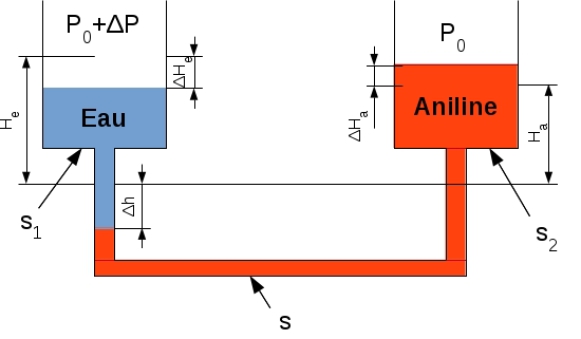
\(P_i = (P_0+\Delta P) +\rho_e g(H_e-\Delta H_e+\Delta h)\) (2)
Indice
On a conservation du volume d'eau donc :
\(\Delta He S_1=\Delta h s\)
\(\Delta H_e = \frac{\Delta hs}{S_1}\)
Indice
De même pour l'aniline :
\(\Delta H_a = \frac{\Delta hs}{S_2}\)
et \(P_i = P_0 +\rho_a g(H_a+\Delta H_a+\Delta h)\) (3)
Indice
(2) et (3) puis (3) \(\Rightarrow\) \((\cancel{P_0}+\Delta P) +\rho_e g\left(\cancel{H_e}+\Delta h\left(1-\frac{s}{S_1}\right)\right) = \cancel{P_0} +\rho_a g\left(\cancel{H_a}+\Delta h\left( 1+\frac{s}{S_2}\right)\right)\)
\(\Rightarrow\) \(\Delta P +\rho_e g\Delta h\left(1-\frac{s}{S_1}\right) = \rho_a g\Delta h\left( 1+\frac{s}{S_2}\right)\)
\(\Rightarrow\) \(\Delta h = \frac{\Delta P}{\rho_a g\left( 1+\frac{s}{S_2}\right)-\rho_e g\left(1-\frac{s}{S_1}\right)}\)
Solution
A.N. \(\frac{\Delta h}{\Delta P} = 2.2\ 10^{-3} \ m\ Pa^{-1}\ \Rightarrow \) Manomètre très sensible
Exercice 5
Un solide hémisphérique de rayon R repose sur le fond d'un récipient contenant un fluide incompressible de masse volumique \(\rho\). La surface libre du fluide est à une hauteur \(h\) par rapport au fond horizontal. La pression à l'air libre et la pression au fond du récipient sont respectivement notées \(P_0\) et \(P_1\).
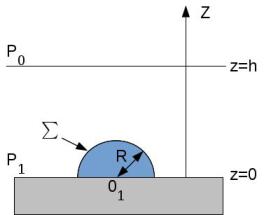
Question
Déterminer par un calcul direct, la résultante des forces de pression sur la surface \(\Sigma\) du solide en contact avec le fluide.
Quelle remarque vous inspire l'expression obtenue ?
Donner un autre méthode de calcul, plus rapide, permettant d'obtenir ce résultat.
Indice
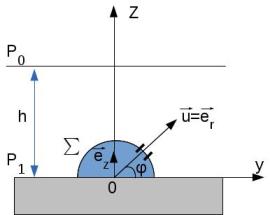

\(x=r\ cos \varphi\ cos \theta\)
\(y=r\ cos\varphi\ sin \theta\)
\(z = r\ sin\varphi\)
Indice
Résultantes des forces de pression :
\(\overrightarrow{F} = \displaystyle \iint_\Sigma \overrightarrow{dF}=\iint_\Sigma \overrightarrow \sigma dS =\iint_\Sigma -PdS\vec{u}\)
avec \(\vec{u} = cos\varphi\ \vec{\omega} + sin \varphi\ \overrightarrow{e_z} = \overrightarrow{e_r}\) et \(\vec{\omega} = cos\theta\ \overrightarrow{e_x}+sin\theta\ \overrightarrow{e_y} = \overrightarrow{e_e}\)
Indice
d'après la loi de l'hydrostatique entre \(A\) et \(M\)
\(P_A+\rho g x_3^{A}=P_M+\rho g x_3^{M}\)
\(P_0+\rho g h=P_M+\rho g x_3\)
\(P_M=P =P_0+\rho g (h-x_3)\)
Indice
l'expression de \(dS\) est donnée par le paramétrage de \(\Sigma\).
On a :
\(\Sigma=\left\{ (x_1,x_2,x_3-\in \mathbb{R}^3 \right\}\ \ \ x_1=R\cos \varphi\cos \theta ; x_2=R\cos\varphi\sin \theta; x_3 = R\sin\varphi\ \ \ (\theta, \varphi)\in[0 ;2\pi]x[0 ;\pi/2]\)
donc :
\(\gamma :\left\{ \begin{array}{l}x_1=R\cos\varphi \cos\theta=\gamma_1(\varphi,\theta)\\ x_2=R\cos\varphi \sin\theta=\gamma_2(\varphi,\theta)\\ x_3=R\sin \varphi=\gamma_3(\varphi , \theta)\end{array} \right.\)
Indice
\(\frac{\partial\gamma}{\partial\theta}= \hspace{3cm }\frac{\partial\gamma}{\partial\varphi}= \)
Indice
\(\frac{\partial\gamma}{\partial\theta}= \left( \begin{array}{l}-R\cos\varphi \sin \theta\\R\cos \varphi\cos\theta\\0\end{array}\right) \ \ \ \ \frac{\partial\gamma}{\partial\varphi}= \left( \begin{array}{l}-R\sin\varphi \cos \theta\\-R\sin \varphi\sin\theta\\R\cos\varphi\end{array}\right)\)
Indice
\(\frac{\partial\gamma}{\partial\theta} \wedge \frac{\partial\gamma}{\partial\varphi}= \)
Indice
\(\frac{\partial\gamma}{\partial\theta} \wedge \frac{\partial\gamma}{\partial\varphi}= \left( \begin{array}{l}R^2\cos^2\varphi \cos \theta\\R^2\cos^2 \varphi\sin\theta\\R^2\cos\varphi\sin\varphi\sin^2\theta+R^2\cos\varphi\sin\varphi\cos^2\theta=R^2\cos\varphi\sin\varphi\end{array}\right)\)
Indice
\(\left\| \frac{\partial\gamma}{\partial\theta} \wedge \frac{\partial\gamma}{\partial\varphi}\right\|=\)
Indice
\( \left\| \frac{\partial\gamma}{\partial\theta} \wedge \frac{\partial\gamma}{\partial\varphi}\right\|=\sqrt{R^4\cos^4\varphi+R^4\cos^2\varphi\sin^2\varphi}=R^2\cos\varphi\)
donc \( dS=\left\| \frac{\partial\gamma}{\partial\theta} \wedge \frac{\partial\gamma}{\partial\varphi}\right\|d\theta d\varphi=R^2\cos\varphi d\theta d\varphi\)
Indice
\(\overrightarrow{F} = \displaystyle \int_0^{2\pi} \int_0^{\pi/2} -P\underbrace{\vec e_r}_{\vec{u}} \underbrace{R^2\cos\varphi d\theta d\varphi}_{dS} =\)
Indice
\(\overrightarrow{F} = \displaystyle \int_0^{2\pi} \int_0^{\pi/2} -\left[P_0+\rho g (h-R \sin\varphi)\right]\left(R^2\cos^2\varphi\cos\theta \vec e_1+R^2\cos^2\varphi\sin\theta \vec e_2+R^2\cos\varphi\sin\varphi \vec e_3 \right)d\theta d\varphi\)
Indice
\(\overrightarrow{F} = \vec e_1 \displaystyle \int_0^{2\pi} \int_0^{\pi/2} R^2\cos\theta d\theta...+\vec e_2 \displaystyle \int_0^{\pi/2} \int_0^{2\pi} \sin\theta d\theta... +\vec e_3 \displaystyle \int_0^{2\pi} \int_0^{\pi/2}-\left[P_0+\rho g (h-R \sin\varphi)\right]R^2\cos\varphi\sin\varphi d\theta d\varphi \)
Indice
\(\overrightarrow{F} = \vec e_3 2\pi \displaystyle \left[ \int_0^{\pi/2}-(P_0+\rho g h)R^2\cos\varphi\sin\varphi d\varphi+ \int_0^{\pi/2}\rho g R^3\cos\varphi\sin^2\varphi d\varphi\right] \)
\(= \vec e_3 2\pi \left[ -(P_0+\rho g h)R^2\left[ \displaystyle\frac{1}{2}\sin^2\varphi\right]^{\pi/2}_0+\rho g R^3 \left[ \displaystyle\frac{1}{3}\sin^3\varphi\right]^{\pi/2}_0\right]\) aide de math
Indice
\(\overrightarrow{F} =\left( \rho g \displaystyle\frac{2}{3} \pi R^3-(P_0+\rho g h )\pi R^2\right)\vec e_3\)
Indice
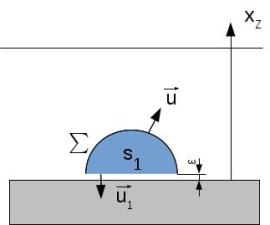
Solution
\(\displaystyle \overrightarrow{P_A}=\iint_{(\Sigma + S_1)}-P\vec{u}dS=\iint_\Sigma -P\vec{u}dS+\iint_{s_1}-P\overrightarrow{u_1} ds\)
\(\displaystyle \overrightarrow{P_A}=\overrightarrow{F}-\iint_{s_1}P_1\overrightarrow{u_1} ds\)
\(\frac{2}{3} \pi R^3 \rho g \overrightarrow{e_z}=\overrightarrow{F}-P_1S_1\overrightarrow{u_1}=\overrightarrow{F}+P_1S_1\overrightarrow{e_z}\)
\(\overrightarrow{F}=\left( \frac{2}{3} \pi R^3 \rho g -P_1\pi R^2\right)\overrightarrow{e_z}=\left[\rho g \frac{2}{3}\pi R^3-(P_0+\rho g h)\pi R^2\right] \overrightarrow{e_z}\)
Exercice 6
La température est la pression étant respectivement \(T_0=0\ °C\) et \(P_0=1\ bar\) au niveau de la mer \((x_3=0)\).
Question
Calculer la pression au sommet de l'Everest \((8880\ m)\) dans l'hypothèse \(T=Cte\).
Indice
\(T= cte\), masse gazeuse isotherme
\(\rho \vec{g}-\nabla P = 0 \Rightarrow \left\{ \begin{array}{l}\displaystyle \frac{\partial P}{\partial x_1}=0 \\ \frac{\partial P}{\partial x_2}=0 \\ \frac{\partial P}{\partial x_3}=-\rho g \end{array} \right.\)
Indice
\(\frac{d P}{d x_3}=-\rho g\)
\(dP=-\rho(x_3) g dx_3\)
Indice
\(PV = nRT \Rightarrow \frac P \rho = rT\) avec \(\frac RM = r\)
\(dP=-\frac{P}{rT}gdx_3\)
Indice
\(\frac{dP}{P}=-\frac{1}{rT}gdx_3\)
Indice
\(\ln \frac{P}{P_0}=-\frac{1}{rT}gx_3\)
Solution
\(P = P_0 e^{-\frac{\rho_0g}{P_0}\displaystyle x_3}\)
AN : \(P = 3.28 \ 10^4\ Pa\)
Méthode :
\(T_0 = 273\ K\)
\(\rho_0 = \frac{P_0}{rT_0} = 1.28\ kg\ m^{-3}\)
\(r = \frac{8.31}{29\ 10^{-3}}\)
Question
Un modèle plus réaliste suppose que l'atmosphère est polytropique. Ce modèle conduit à une variation de la température linéaire avec l'altitude : \(T=T_0-ax\).
Sachant que \(a = 6.5\ K\ km^{-1}\), donner la valeur de la constante \(k\).
Calculer avec ce nouveau modèle la température et la pression au sommet de l'Everest.
Indice
Masse d'air polytropique : \(T = T_0\left[1-\frac{k-1}{k}\frac{\rho_0g}{P_0}x_3\right]\)
Indice
ici , \(T=T_0-ax_3\Rightarrow \)masse d'air polytropique avec \(a=T_0\frac{k-1}{k}\frac{\rho_0g}{P_0}\)
Indice
\(k=1.235\)
d'où : \(P=P_0\left[1-\frac{k-1}{k}\frac{\rho_0 g}{P_0}x_3\right]^{k/k-1}\)
Indice
\(P = 2.78\ 10^4\ Pa = 0.278\ bar\)
Indice
Autre méthode :
\(T = T_0-ax_3\)
\(dP = -\rho(x_3)gdx_3 \Rightarrow dP = -\frac{P}{rT}gdx_3\)
Indice
\(\displaystyle \int \frac{dP}{P}=-\frac gr \int \frac{dx_3}{T} = -\frac gr \int \frac{dx_3}{T_0-ax_3}\)
Indice
\(ln \left( \frac{P}{P_0}\right) = -\frac gr \left[-\frac 1a\ln \left( T_0-ax_3\right)\right]_0^{x_3}\)
\(ln \left( \frac{P}{P_0}\right) =\frac{g}{ra}\ln\left( \frac{T_0-ax_3}{T_0}\right)\)
Indice
\(\frac{P}{P_0} = \left( \frac{T_0-ax_3}{T_0}\right)^{g/ra}\)
Solution
\(P =P_0 \left( \frac{T_0-ax_3}{T_0}\right)^{g/ra}\)
\(AN : P = 2.86\ 10^4\ Pa = 0.286\ bar\)
\(T = T_0-ax_3 = 215.28\ K = -57.87\ °C\)
Méthode :
Question
En déduire la température d'ébullition de l'eau.
Indice
Loi d'Antoine : \(\log P=A-\frac{B}{T+C}\) avec\( \left\{ \begin{array}{l} A = 7.06252\\ B=1650.270 \\ C=226.346 \end{array}\right.\)
\(T_{eb} = \frac{B}{A-\log P}-C\)
Solution
\(T_{eb} = 68\ °C\)
Complément :
\(P\) en \(kPa\) : \(P=28.6\ kPa\)
Remarque : Pour continuer à briller en société
\(P_{V\ sat}(-57\ °C)\) du butane \(= 0.057\ bar\)
\(P(8880\ m)=0.286\ bar>0.059\ bar\) le butane ne peut pas sortir de la bouteille !
\(P_{V\ sat}(25\ °C)\) du butane \(= 2.8\ bar> 1\ bar\)